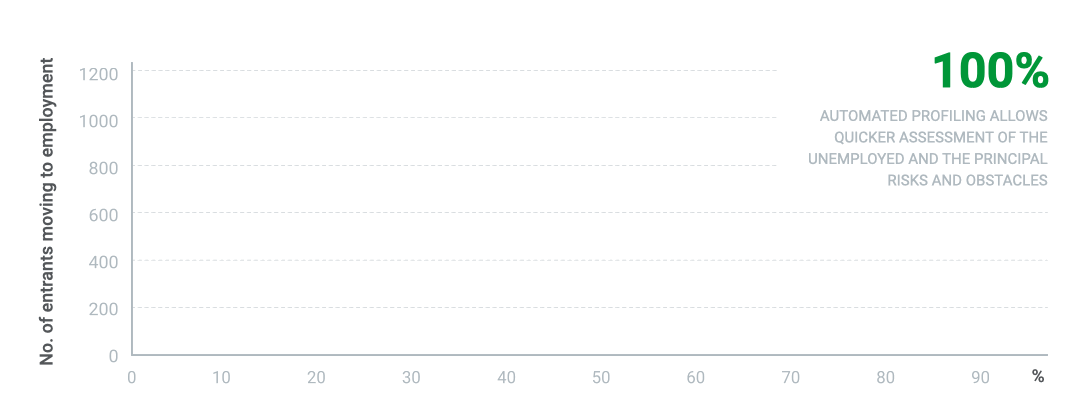
Case study
Estonian Unemployment Insurance Fund prevents unemployment with Artificial Intelligence
Being unemployed is not only difficult for a citizen but also costly for the government, especially if it lasts more than six months. The longer a person is without a job, the harder it is for them to find the next one. And for the state, it negatively affects GDP – more money is spent on unemployment benefits and workforce retraining, and more time is spent on counseling. In 2020, the Estonian Unemployment Insurance Fund decided that AI adoption in the public sector would help to tackle long-term unemployment and help people get back to work faster.

Challenge
Missing the bigger picture
The trouble with the current process of understanding and counseling clients with job loss is the considerable number of resources required to work through extensive background information of all the customers and get a complete overview of the caseloads.
Profiling data per one unemployed person comprises 45 separate indicators, from socio-demographics, prior employment history, labor market characteristics, and up-to-date health data and job vacancies. The abundance of data makes it laborious and error-prone to distinguish the unemployed who have more difficulties getting back into the labor market and should receive more attention and resources. In addition, the state is missing an overview of whether the implemented measures and current labor market policies are relevant and cost-effective.
Solution
Reducing the harmful effects of unemployment
To keep unemployment time as short as possible, raise the quality of the services provided to the unemployed, and increase the efficiency of organizational processes, the Estonian Unemployment Insurance Fund (EUIF) partnered with Nortal. In collaboration with the Center for IT Impact Studies (CITIS) and Resta, Nortal developed an AI-powered decision-support tool (OTT) that predicts the risk of long-term unemployment.
The OTT tool helps EUIF counselors better understand their customers’ situations by calculating the probability of getting a new job and the level of risk of becoming unemployed again. Moreover, OTT provides counselors with information which factors impact the risk score most and unveil the possible reasons for unemployment.
The decision-support tool collects data from many public registries connected via X-Road and analyses information over the last five years, including salaries from the Tax Office, education from the Board of Education, and subsidies from the Social Welfare Office.
As a result, with the help of OTT, counselors can distinguish low-risk applicants from high-risk ones. The first group is most likely able to find the next job independently, but the second needs detailed assistance. OTT allows counselors to focus on jobseekers with the highest risk of prolonged unemployment. In addition, the tool provides EUIF with a more profound understanding of the labor market’s condition and helps to develop data-based labor.
3,8%
of Estonia’s yearly expenditures were saved by reducing unemployment by a single day
95%
forecast accuracy
100%
visibility of the unemployed, risks, and regional trends daily
Impact
Planning labor policies with real-time data
With the help of Machine Learning, the Estonian government has a management tool for implementing and planning policy measures with a real-time prediction of long-term unemployment risks and automated suggestions of the best ways to prevent them.

— The Estonian Unemployment Insurance Fund (EUIF)
The solution is an AI-powered decision support tool, which supplements the official data from multiple government registries and the extensive experience of the counselors in helping people get back into the labor market.
Result
Helping people get back to work faster
In 2021, the AI-powered decision support tool OTT was awarded The Best Data-Based Digital Service in the Estonian public sector. EUIF counselors are utilizing this solution daily, with positive results. The decision-support tool shows the counselors where to put their effort and priorities, helping them make better decisions when allocating resources to those who need them the most.
Further, the practical experience of using AI has opened new possibilities for how the calculations resulting from automated impact assessment solutions can be applied – for example, providing evidence-based information on how benefits and subsidies affect the movement to work and if the current measures are relevant and cost-effective. As a positive side-effect of these types of solutions, the state will have a real-time overview of the current unemployment status on an individual, regional, and state-wide level, helping understand the labor market’s ongoing processes better and take a proactive role in developing effective labor policies.

Get in touch
Let us offer you a new perspective.


